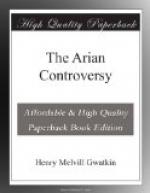[Sidenote: Retirement of the Semiarians.]
The next move was to find out whether the Semiarians were willing to share the victory of the Nicenes. As they were still a strong party round the Hellespont, their friendship was important. Theodosius also was less of a zealot than some of his admirers imagine. The sincerity of his desire to conciliate Eleusius is fairly guaranteed by his effort two years later to find a scheme of comprehension even for the Anomoeans. But the old soldier was not to be tempted by hopes of imperial favour. However he might oppose the Anomoeans, he could not forgive the Nicenes their inclusion of the Holy Spirit in the sphere of co-essential deity. Those of the Semiarians who were willing to join the Nicenes had already done so, and the rest were obstinate. They withdrew from the council and gave up their churches like the Arians. They comforted themselves with those words of Scripture, ’The churchmen are many, but the elect are few.’[17]
[Footnote 17: Matt. xx. 16.]
[Sidenote: Close of the council.]
Whatever jealousies might divide the conquerors, the Arian contest was now at an end. Pontus and Syria were still divided from Rome and Egypt on the question of Flavian’s appointment, and there were the germs of many future troubles in the disposition of Alexandria to look for help to Rome against the upstart see of Constantinople; but against Arianism the council was united. Its first canon is a solemn ratification of the Nicene creed in its original shape, with a formal condemnation of all the heresies, ’and specially those of the Eunomians or Anomoeans, of the Arians or Eudoxians (Homoeans), of the Semiarians or Pneumatomachi; of the Sabellians, Marcellians, Photinians, and Apollinarians.’
[Sidenote: The spurious Nicene creed.]
The bishops issued no new creed. Tradition indeed ascribes to them the spurious Nicene creed of our Communion Service, with the exception of two later insertions—the clause ‘God of God,’ and the procession of the Holy Spirit ‘from the Son’ as well as ‘from the Father.’ The story is an old one, for it can be traced back to one of the speakers at the council of Chalcedon in 451. It caused some surprise at the time, but was afterwards accepted. Yet it is beyond all question false. This is shown by four convergent lines of argument. In the first place, (1.) it is a priori unlikely. The Athanasian party had been contending all along, not vaguely for the Nicene doctrine, but for the Nicene creed, the whole Nicene creed, and nothing but the Nicene creed. Athanasius refused to touch it at Sardica in 343, refused again at Alexandria in 362, and to the end of his life refused to admit that it was in any way defective. Basil himself as late as 377 declined even to consider some additions to the incarnation proposed to him by Epiphanius of Salamis. Is it likely that their followers would straightway revise




